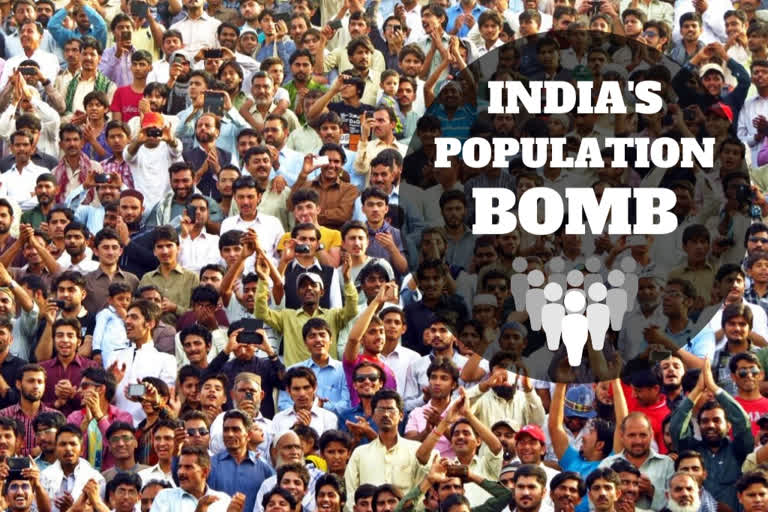Hyderabad: An Indian proverb suggests that buttermilk gets diluted when the number of consumers increases. This holds true for our country, as according to a UN report, India, currently the second-most populated nation, will surpass China and top the list by 2027.
On August 15, addressing the nation from Red Fort, Prime Minister Narendra Modi had expressed concern over the issue of population explosion, blaming it for creating problems for present and future generations. He also batted for the pattern of small families, saying they would help push for more welfare in the country. The Prime Minister announced that India has to overcome the challenge of population explosion through the perfect plan of action as decisions based on political benefits and losses only go on to cause immeasurable damage to the nation.
With the failure of population control schemes posing a big threat to national progress, Niti Ayog plans afresh to prepare a draft plan for population control. UN has estimated that India, Nigeria, and Pakistan among nine nations will contribute more than 50 per cent of the world population until 2050. Keeping this in view, Niti Ayog seriously plans for pushing a perfect plan of action on the right tracks to check population explosion by 2035.
The national fertility rate, which was five per cent 50 years ago, came down to 3.1 per cent in 1991 and further dipped to 2.3 per cent in 2013. Although it is true that the present 137 crore population has thrown a big challenge to the planners.
Niti Ayog has found that 30 per cent of the total population is in the age groups of reproduction and about three crore married women are deprived of family planning facilities. In order to reach the targets of sustainable development, there is a need for creating awareness among couples to opt for opportunities to check the problem of unwanted pregnancies. Also, it is rife time for ensuring better facilities and provide improved services to control the population. Urgent need of the hour is to sharpen efficient strategies in that direction.
Read: Population control have been given religious colors: Rashid Alvi
India is the first country in the world to identify the need for population control. It had also mentioned the words "limited family" in its first five-year plan.
However, in its 72 years of independence, India has added around 100 crore to its population. When the National Population Policy was formulated in 2000, the fertility rate was pegged at 3.2 per cent and has now declined to 2.2 per cent.
Though it is true that population explosion is more pronounced in Uttar Pradesh and Bihar, a few public interest litigations urge courts to direct governments to strictly implement an Act for two children norm across the country. The case reached the Supreme Court when the Delhi High Court last September refused to give directions for promulgating such Acts.
In 1976, the 42nd Constitutional Amendment sought to provide an effective population control measure through the Acts. Justice Venkatachalaiah Commission had recommended the amendment, which offers to give powers to Centre and state governments for the same and check population explosion. A related PIL and the other three cases are now pending in the Supreme Court.
Though the fertility rate came down by 23 per cent in the new millennium, population explosion is still rampant in states like Bihar, Meghalaya, Nagaland, UP, Manipur and Jharkhand.
Since mere court directions and Parliament Acts cannot resolve the growing problem of population explosion, the Centre and the state governments have to act swiftly to start measures at a basic level.
Modi Government had launched a big program "Mission Parivar Vikas" two and half years ago in the 146 most-populated districts across the country. These districts contribute 44 per cent of the country's population and are a part of states like Bihar, Madhya Pradesh, Rajasthan, UP, Chhattisgarh, and Assam.
Read: Rising population like cancer, can become incurable: Giriraj
Further, 115 districts from these states have registered a large number of mothers of adolescent age, 25 to 30 per cent deaths during delivery, and also witness about 50 per cent infant deaths.
The Centre had already made an announcement to expand awareness programmes and provide anti-pregnancy equipment and aid to achieve targets like population control and social health security. However, it is not known to what extent the scheme of population control was successful.
Experts warn against any proposal of Acts and cases for punishment and denial of rights for those who violate two children norms like voting, contesting elections, property, free legal help, and housing.
An economic survey in 2018 divulged that - Indian society, which has been accustomed to vying for a male child, has achieved the dubious distinction of aborting a staggering number of 2.10 crore female children.
At this juncture, the population in India can be stabilized by strengthening the Asha workers team, Anganwadi centres, primary health centres and increasing social awareness.
Read: Muslim Rashtriya Manch welcomes PM's take on 'population explosion'



